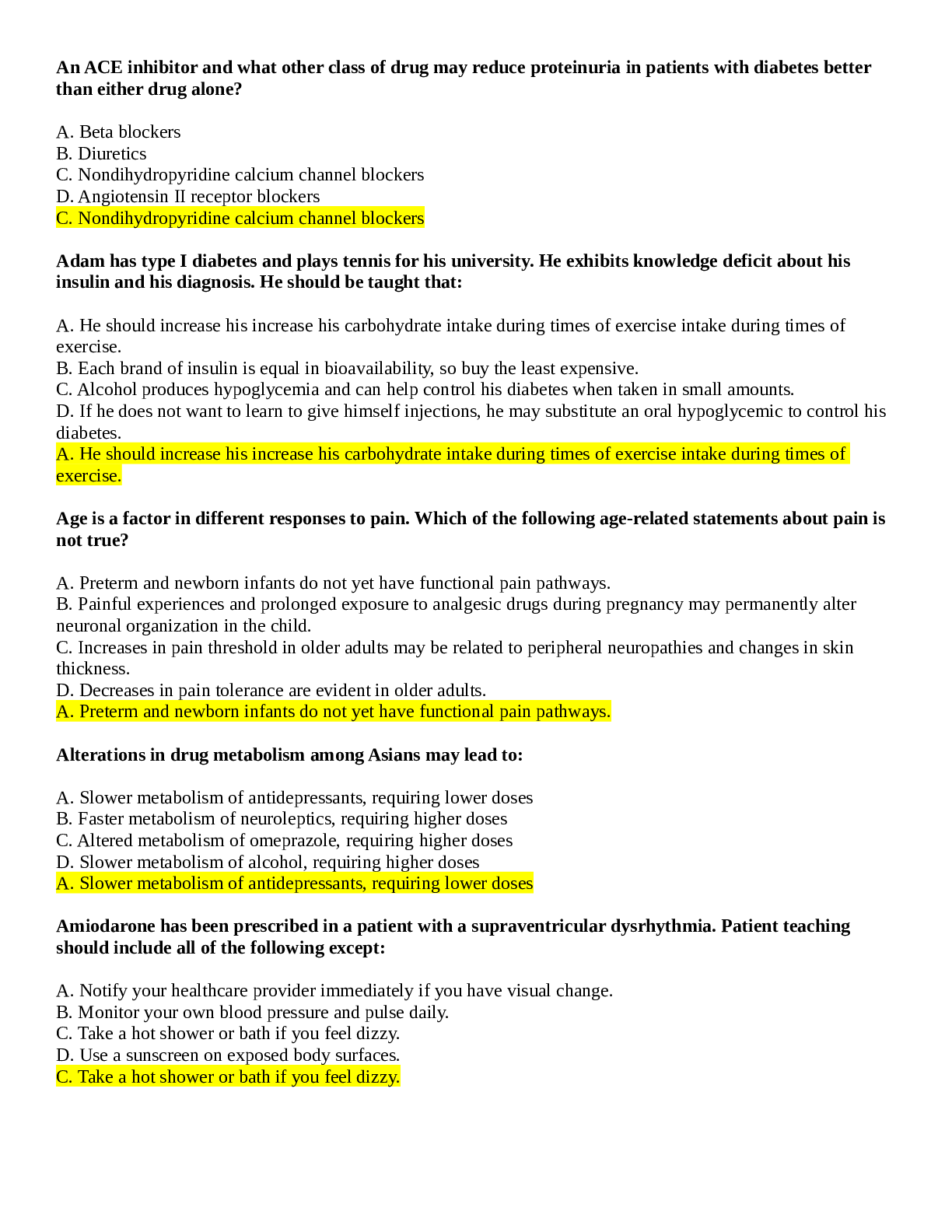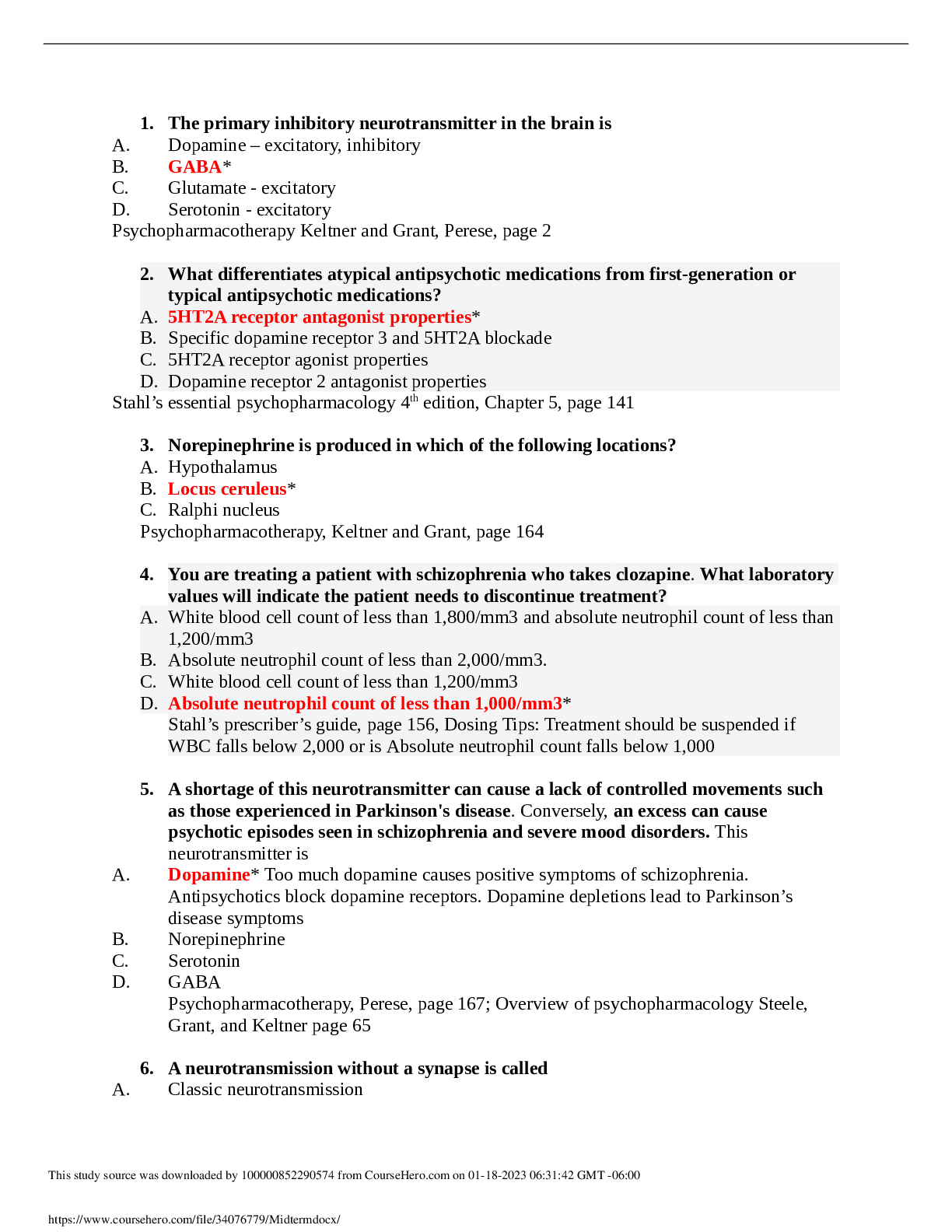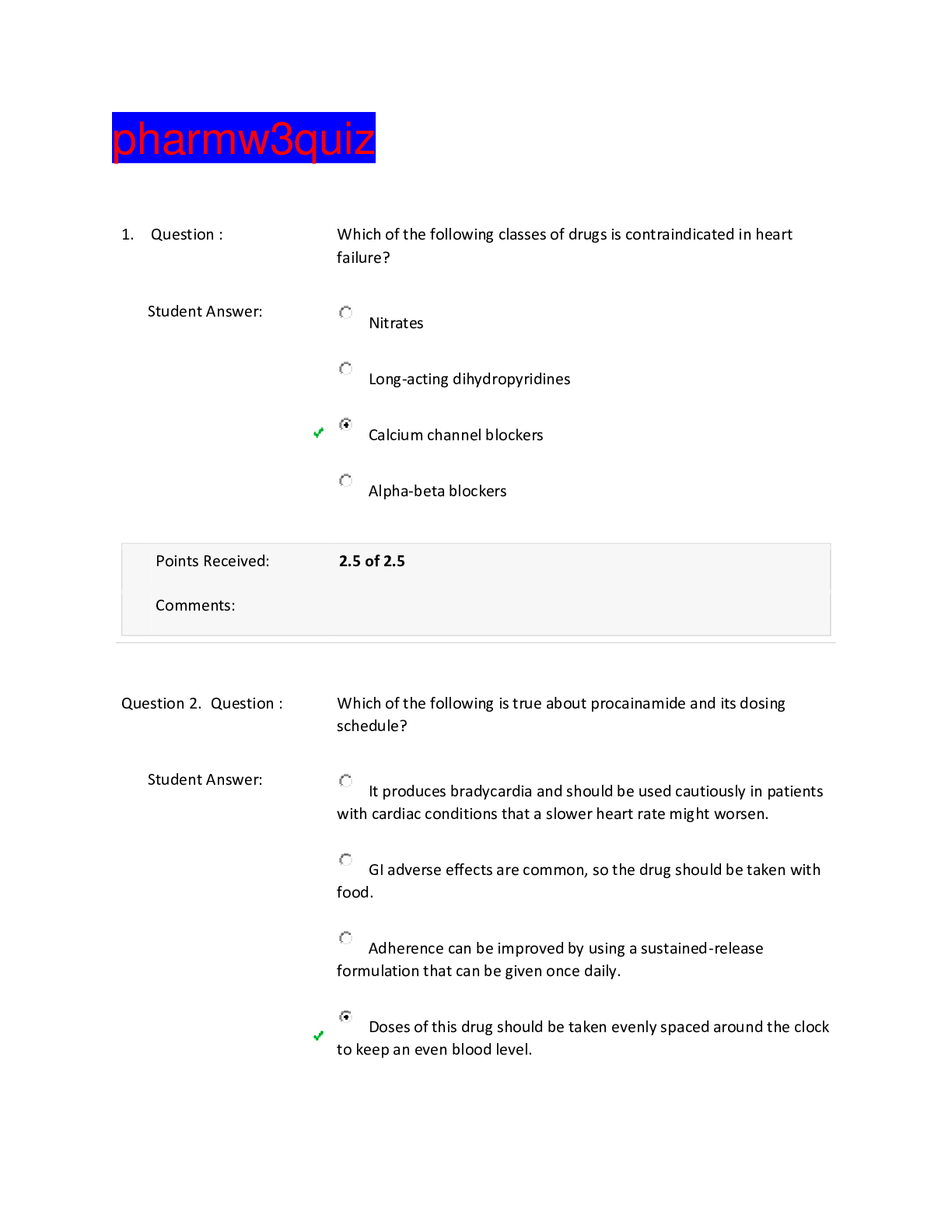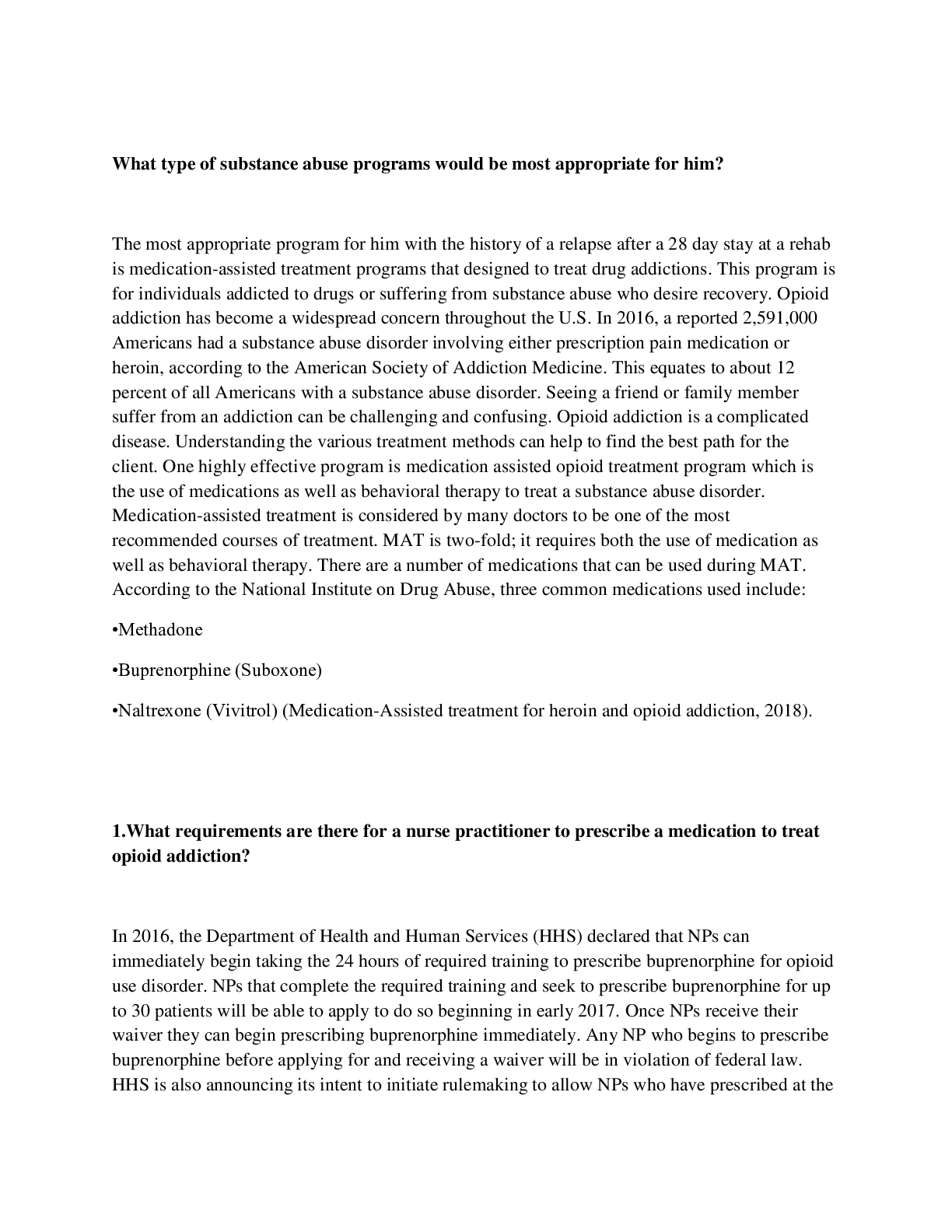NURSING NSG6005Wk2D1 document with relevant points
Document Content and Description Below
NURSING NSG6005 Wk2D1.docx Gami is a 48-year-old who you discover when completing a health history is taking cinnamon to treat Type II Diabetes. She is specifically using cassia Cinnamon. You also d... iscover that she is taking Ginseng to assist with memory. Her prescribed medications are Aricept and Coumadin. Ms. GM is a 48-year-old who presents to your clinic to establish care. During the health history, you learn that she has a history of Type II Diabetes. When asked about prescription and nontraditional medications, she reports being prescribed Aricept, Coumadin, Cassia cinnamon for Type II Diabetes and Ginseng for memory. Is there any additional subjective or objective information you need for this client? Explain. Based on Gami’s current medications, there is a lot left unsaid regarding her past medical history. A comprehensive assessment is essential to establish primary care. The interview process for subjective data should include asking about chief complaint, anything in particular disturbing her or does she present to establish care? If there is a particular complaint, further investigate using OLDCARTS acronym and a review of systems. A detailed review of past medical history, family medical history, surgical history, social history including ethnic background or cultural preferences important to planning her care. In a respectful manner, question her choice for alternative nontraditional medicine to treat her diabetes. Identify Complete a head to toe physical examination. Obtain a complete set of vital signs, height, weight and calculate a body mass index. Ask Gami why she is taking Coumadin, what is her current dose and who has previously managed her prothrombin and international normalized ratio. Question her history related to Type II Diabetes, including onset, last hemoglobin A1C, does she self-monitor blood sugars daily, review her glucometer if available, does she take any medications to control her blood sugars or is it controlled with diet and alternative therapies. Baseline diagnostic test would include a HgA1C. A glycosylated hemoglobin values reflect average blood sugar levels for the 2- to 3-month period before the test to provide differentdiabetic treatment (Fischbach, 2014). Also, will draw a PT/INR to monitor bleeding time for possible dose adjustment for Coumadin. Fischbach (2014) states the PT is one of the four most important screening tests used in diagnostic coagulation studies”. (p. 158) What would be your position on the Ms. GMs use of alternative supplements for her diabetes and memory? Explain and include contraindications, if any. Integrative medicine has become a large part of healthcare today. Respecting a patient’s wishes for choosing alternatives to traditional medicine is an important aspect to patient centered care. However, she should be educated on the use of dietary supplements are not currently approved by the U.S. Food and Drug Administration (FDA) (Buttaro et al., 2017). Many controversial studies can be researched to support the use of Cassia cinnamon while others oppose it. In the research found through the library, there is evidence cinnamon has not effect on glycemic control (Dugoua, Seely, Perri, Cooley, Forelli, Mills, & Koren, 2007). Whereas, Buttaro et al. (2017) report cinnamon has been used in supporting healthy glucose levels in those with glucose intolerance and type 2 diabetes mellitus. According to Psychopharmacology (2000) there was an average improvement of 7.5% and reflected improvements to a number of different aspects of memory, including working and long-term memory in a clinical trial to test efficacy of ginseng. Potential interactions between cinnamon bark and warfarin are labeled as “significant”, meaning that there is a higher chance of an interaction occurring and are not recommended for use together. Cinnamon bark is far more common in causing drug interactions with diabetic medications, increased bruising and bleeding risk has been reported in patients taking warfarin and using cinnamon bark (Drug Interactions with Cinnamon Bark Oral and Warfarin Oral, 2015).Are there any additional test/assessments you would complete for this patient given this list of medications? Explain. Healthy literacy screening is important for providing education. Performing an assessment on the level of education is critical to the teaching process. Baseline diagnostic test would include a fasting plasma glucose and a HgA1C. A glycosylated hemoglobin values reflect average blood sugar levels for the 2- to 3-month period before the test to provide different diabetic treatment (Fischbach, 2014). The Hbg A1c goal for most patients is generally less than 7% per ADA guidelines, a more stringent goal of 6.5% may be established for some patients if there is no significant hypoglycemia or other adverse effects (Woo, 2015). I would recommend Gami keep her Hgb A1c around 6.5% to prevent any long-term complications. Also, will draw a PT/INR to monitor bleeding time for possible dose adjustment for Coumadin. Fischbach (2014) states the PT is one of the four most important screening tests used in diagnostic coagulation studies”. (p. 158) I will have a basic metabolic panel to evaluate renal function secondary to the prescribed metformin. How might your treatment plan, in terms of medications, differ for this patient? Include the class of the medication, mechanism of action, route, the half-life; how it is metabolized in and eliminated from the body; contraindications and black box warnings. I would encourage Gami discontinue the cinnamon and ginseng for two main reasons, the use of these supplements is not approved for the treatment of disease processes by the FDA and the increased risk for bleeding related to the cinnamon and ginseng. The first line drug of choice begins with metformin (Woo, 2015). Metformin is the only currently approved member of the class of drugs known as the biguanides. According to Pawlyk, Giacomini, McKeon, Shuldiner, &Florez (2014) it is available in a standard and extended-release. About 50% of an orally administered dose is absorbed into the systemic circulation. The half-life of the drug measured in plasma is between 4 and 8 h in individuals without renal dysfunction, and the clearance exceeds glomerular filtration rate, consistent with tubular secretion (Pawlyk et al., 2014). I would begin metformin 500 mg daily and titrate up to obtain the maximum effect. Metformin has been known to cause gastrointestinal side effects including diarrhea but eventually lessen over time. Metformin is contraindicated in individuals with impaired renal function. The U.S. Food and Drug Administration (FDA) strongly recommends against use of metformin in some patients whose kidneys do not work normally due to the increased risk of lactic acidosis. The labelling was revised in 2016 with the recommendations that metformin-containing medicines expand the use in certain patients with reduced kidney function (2016). What health maintenance or preventive education is important for this client based on your choice medication/treatment? Health promotion begins with education. Diabetes self-management is essential to promote optimal health. Encourage Gami to actively participate in planning her care while setting selfcentered goals. I will begin the education process and teaching at today’s visit. Diabetes is a complex disease and extensive education is necessary to prevent further complications. Educate Gami on metformin indication, dose, scheduling at the same time every day and potential side effects. Instruct Gami if potential side effects are troublesome, notify my office or return prior to scheduled follow up. Instruct her on daily fingerstick blood sugar monitoring, recording in daily log and instruct on bringing meter and log to follow up appointment. Her target fasting blood sugar should be between 70 mg/dL - 130 mg/dL. Gami will require teaching on a regularexercise program and a healthy diet. Inform Gami importance of adhering to the plan and abiding to the education provided to attain the best control.References Buttaro, T. M., Trybulski, J., Polgar-Bailey, P., Sandberg-Cook, J. (2017). Primary Care: A Collaborative Practice, 5th Edition. [South University]. Retrieved from https://digitalbookshelf.southuniversity.edu/#/books/9780323355018/ Drug Interactions with Cinnamon Bark Oral and Warfarin Oral. 2015. RxList. Retrieved August 30, 2017 from web site: http://www.rxlist.com/drug-interactions/cinnamon-bark-oraland-warfarin-oral-interaction.htm Dugoua, J., Seely, D., Perri, D., Cooley, K., Forelli, T., Mills, E., & Koren, G. (2007). From type 2 diabetes to antioxidant activity: a systematic review of the safety and efficacy of common and cassia cinnamon bark. Canadian Journal of Physiology & Pharmacology, 85(9), 837-847. doi:10.1139/Y07-080 Fischbach, F. (01/2014). A Manual of Laboratory and Diagnostic Tests, 9th Edition. [South University]. Retrieved from https://digitalbookshelf.southuniversity.edu/#/books/9781451195200/ Pawlyk, A. C., Giacomini, K. M., McKeon, C., Shuldiner, A. R., & Florez, J. C. (2014). Metformin pharmacogenomics: current status and future directions. Diabetes, 63(8), 2590-2599. doi:10.2337/db13-1367 Wesnes, K., Ward, T., McGinty, A., & Petrini, O. (2000). The memory enhancing effects of a Ginkgo biloba/Panax ginseng combination in healthy middle-aged volunteers. Psychopharmacology, 152(4), 353. Woo, T. M. (08/2015). Pharmacotherapeutics for Advanced Practice Nurse Prescribers with DavisPlus Resources, 4th Edition. [South University]. Retrieved from https://digitalbookshelf.southuniversity.edu/#/books/9780803676374/ [Show More]
Last updated: 2 years ago
Preview 1 out of 4 pages

Buy this document to get the full access instantly
Instant Download Access after purchase
Buy NowInstant download
We Accept:

Reviews( 0 )
$12.00
Can't find what you want? Try our AI powered Search
Document information
Connected school, study & course
About the document
Uploaded On
Jan 19, 2021
Number of pages
4
Written in
Additional information
This document has been written for:
Uploaded
Jan 19, 2021
Downloads
0
Views
118








.png)
.png)


